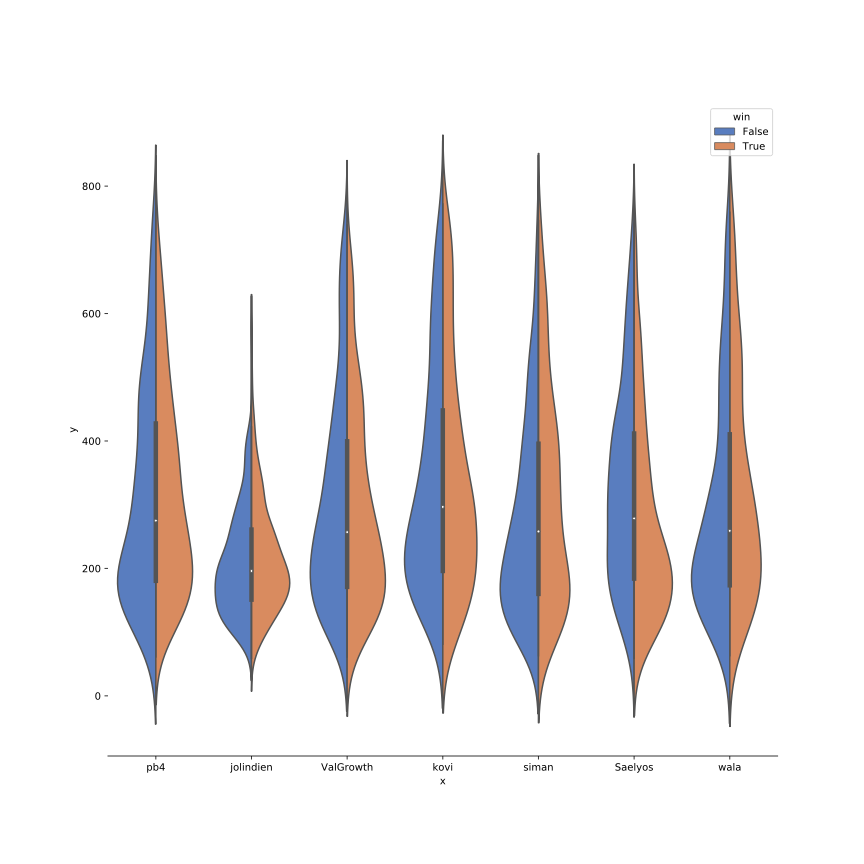I was 14th. It was a nice surprise to have this contest during the lockdown. Even if, I lacked of motivation on the beginning. It is probably the 30 days contest effect. Overall, I think I spent the same time than for a 10 days contest but it was more diffuse :). Well I thank CG and the game authors for this work. Thanks also to all participants, it was nice to chat the day without motivation !
I code in python and I was on the edge concerning time limit. Thus, I had to optimize many aspects of my bot.
Pathfinding
So first step was naturally to be able to choose a path that does not lead to a surface every 5 turns. I used a simple flood fill for this. Depth 2, that is to say, for every direction, I keep the largest of its adjacent continuous component. With depth 1, there is indeed the risk to cut off a big zone in two. At the end I added some features to pass close visited cells. It actually enlarged the paths.
Tracking
I won’t detail all the points of the tracking process as many others did it. I used a tuple structure (rpath, rpos, rmines). “r” is for relative, rpos is the position in the relative map (29x29). Rpath denotes the visited cells and rmines the mining positions. rpath and rmines are bitboards, so this is a 3 integers tuple.
Then for every potential cell of the opponent, I add a set of these tuple with hp states. Then, when I compute a tuple transformation like a “silence”, I do a hash map of the tuple to tuple transformation to only compute it once by tuple. Nevertheless, it was not sufficient for ultra-furtive opponents, you know, the ones that does not load other weapon that silence… So if the number of different tuple was to large, I cut it.
I did not consider probability of presence for the potential cases and the mines. Maybe this was a weakness of my bot.
Evaluation
My decision was based on a heuristic. I considered 8 cases, for every direction with and without surface. For each I evaluated 4 possibilites:
- basic (MOVE)
- attack (MOVE with TORPEDO before or after)
- silence (MOVE then SILENCE)
- attack+silence (MOVE then SILENCE with a TORPEDO anywhere)
Then I complete with mines, trigger and sonars.
I did not have the SILENCE then MOVE option, and already missed some last hit because of it.
Among the items evaluated there were:
- keeping the biggest continuous component for move
- expected damage done to the other
- risk of mine and risk to be targeted by a torpedo
- stealth (log of the number of potential positions)
- item consumed (I had a price by load point, so silence costs basically twice a torpedo)
- distance (If i was winning on hp, I tried to reduce distance)
What I missed ?
I noticed that on the games I lost, a lot were on specific situations that I will call “zoning” and “the final fight”. I wished to have the time, the imagination and the motivation to build a strategy switch for these situations. Let’s detail it.
Zoning
That’s when players cover map with mines and globally split the map in two. With some players like blasterpoard or Illedan, it happened 90 % of time and I generally lost on it. If a player tries to enter the other zone, he has very small chance to win (except to last hit him). So, in this game, one has to make efficient paths to save time and optimize the cases when players cross at frontier and trade some torpedos. An interesting point would be not to move every turn to save time (on surface or mine).
Final fight This is when both players position are known, have no more silence and just blast each other as fast as possible. It needed some depth to guess what would happen… For instance 4 hp vs 4 hp, you think, “I move and strike first and will win”. But the other, reload after the first torpedo and launch the second before you… This needed some analysis of depth simulation but I am pretty sure I could improve on it.
Well, now let’s sleep properly and get ready for next challenge ! 













